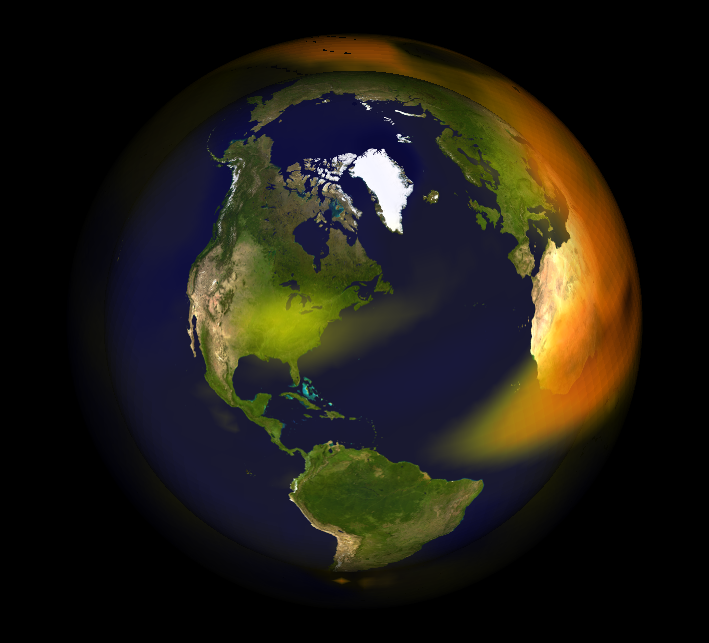Atmospheric Physics, Chemistry and Climate
Tropospheric Aerosols
Introduction
- Aerosols are suspensions in air of microscopic solid or liquid particles.
- They are emitted into the atmosphere both naturally (e.g., sea spray, volcanoes, forest fires, dust) and as a result of human activities (e.g., fossil fuel combustion, biomass/refuse burning, land use changes). They are also created and modified by chemical processes in the atmosphere.
- Aerosols consist of many different chemicals. Their composition and size affects how they absorb or scatter light, whether they are liquids or solids, whether they are acidic, neutral, or basic, how much water vapor they absorb, how effectively they act to form cloud droplets, and how long they reside in the atmosphere.
- The average lifetime of aerosols in the atmosphere is about a week. This lifetime is much too short for them to mix all around the Earth and hence aerosol concentrations are highest near their sources.
- Aerosol particles profoundly affect Earth's climate. They mostly reflect sunlight, and thus cool Earth's surface. They therefore counter the effects of greenhouse gases, which absorb the heat escaping from Earth's surface and thus heat Earth's surface and lower atmosphere. The cooling by human-induced aerosols is roughly comparable to the heating by human-induced carbon dioxide. However, dark colored aerosols (soot) absorb sunlight and heat the atmosphere.
- Aerosols also modify cloud amount, cloud distribution, and cloud properties such as cloud brightness. Aerosols may also influence precipitation amount, distribution, and frequency. Aerosols decrease visibility by scattering and absorbing sunlight. Aerosol deposition to the surface alters ecosystems by changing acid and nutrient balances.
- The major aerosol types are sulfate, black carbon, organic carbon, mineral dust and sea salt.
- The atmospheric Physics and Chemistry group is working on these different aspects of aerosols, and a summary of our research on aerosols is presented on this page.
Aerosol Emission
Various natural and human-induced emissions contribute to
aerosols around the globe. Some aerosol are emitted both naturally and from human activities (e.g. carbonaceous aerosols from natural and human-induced fires). Aerosols are also produced in the
atmosphere by chemical reactions in gas or aqueous phase (e.g. sulfate and secondary organic carbons). These contributions differ from
region to region and their presence varies highly, leading to highly
variable amounts of aerosols in different parts of the globe. Therefore, modeling aerosol emission necessitates to properly characterize the emission rate and the localization of the sources. In addition, the contribution of human-induced emission needs to be known if one wants to know the anthropogenic forcing of the aerosols. Unfortunately, there are many uncertainties for most aerosol types in the emission rate, source location, and human contribution. Our group works on all these aspects.
Aerosol Properties
Aerosol properties (physical, chemical and optical) varies considerably between aerosol types, and because of the high inhomogeneity of aerosol in the atmosphere, as well as atmospheric conditions. Large effort is maintained in our group to compare these properties with observations. Among them, aerosol concentration, composition, extinction (absorption and scattering), size distribution. These properties are preferably compared with satellite data or network of ground-based instruments , giving near global spatial coverage.Aerosol Modeling
Aerosol distribution can be simulated by transport or climate models depending on the application. For air quality, a transport model or climate model with nudged meteorological fields towards re-analysis can better reproduce transport. But to study the effect of aerosols on climate or feedbacks, climate atmospheric model (AGCM) with either fixed sea surface temperature (SST) or coupled with Ocean model (AOGCM) are more appropriate as the cooling of sea surface temperature by aerosol is a key unknown. All these models are developed and maintained at GFDL.
Aerosol Effects on Radiation
Aerosols absorb and scatter shortwave radiation and, for some of them, they also absorb longwave radiation. This interaction with radiation affects the energy budget of the Earth's atmosphere. The key parameters to measure these interactions are the aerosol optical thickness, the single scattering albedo and the phase function. These 3 parameters are generally calculated at all wavelength of the solar spectrum assuming that aerosol are homogeneous spherical particles. This assumption allows to use simple Mie theory knowing the refractive index of the aerosol. But in reality, the shape of these particles may differ from a sphere, or different aerosol types may stick together producing non-homogeneous composition. By comparing the simulated values of the 3 parameters with observations for different aerosol conditions allow us to test our different assumptions.Tropospheric Aerosol and Biogeochemistry
Biological productivity in the surface ocean is frequently limited by the supply of iron, an essential nutrient to marine organisms. Atmospheric transport and deposition of mineral dust particles originating from deserts provides an important source of iron. The fraction of aeolian iron input that is bioavaible depends on aerosol iron solubility in seawater. Measurements show that aerosol iron solubility is low in fresh dust (<1%), increases with time of transport (e.g., as indicated by solubility >10% in remote regions). Both field and laboratory observations show that aqueous coating develops on the surface of dust aerosols through heterogeneous chemistry (i.e., reactions with H2SO4 and HNO3) and through cloud chemistry followed by evaporation of cloud droplets. Mineral dissolution in the aqueous coating may be accelerated by strong acidity, light, and the presence of organic acids. Modeling of these processes in a global atmospheric model is the only method to provide aeolian deposition fluxes ofbioavailable iron to the oceans, including their temporal variation and spatial distribution, for studies of climate and ocean biogeochemistry. In situ measurements of ocean productivity indicate biological response to aeolian iron deposition in the Southern Oceans, consistent with observations during deliberate iron fertilization experiments.
Fan, S., W.J. Moxim, and H. Levy II (2006) Aeolian input of bioavailable iron to the ocean, Geophysical Research Letters, Vol. 33, L07602, doi:10.1029/2005GL024852.
Cassar, N., M.L. Bender, B.A. Barnett, S. Fan, W.J. Moxim, H. Levy II, and B. Tilbrook (2007), The Southern Ocean biological response to aeolian iron deposition, Science, 317, 1067-1070.


